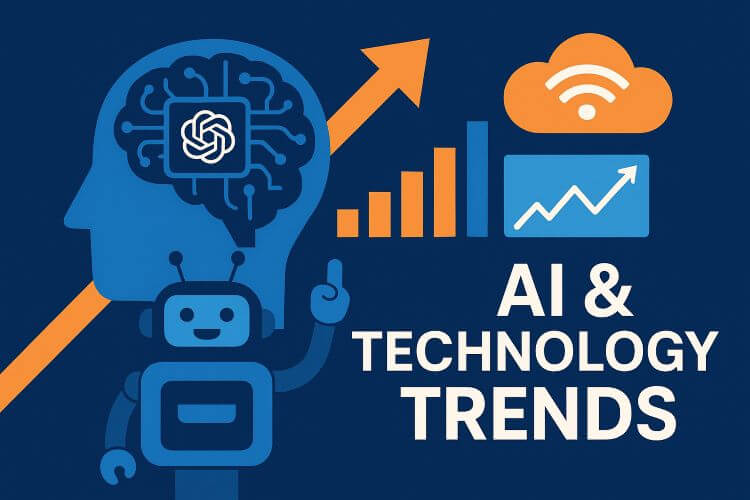AI Navigation
- articleAI Trends
- lightbulb_2AI Tips
- assistant_navigationAI Navigation
- heatHot Articles
- emergency_heat_2Hot Tips
- format_list_numberedPrompt Formatter
- psychologyTest Center(RPI)
AI & Technology Weekly (Aug 4–Aug 8): GPT-5 Sparks Global Buzz, Apple Bets $100B on U.S. Manufacturing
Over the past week, the AI and tech world has remained as vibrant as ever — from OpenAI’s launch of its most powerful GPT-5 to quarterly earnings from tech giants and Apple’s $100B bet on domestic manufacturing, the industry landscape is shifting rapidly. Here are the week’s most notable events and in-depth insights.

1. OpenAI launches GPT-5, ChatGPT tops app charts again
OpenAI has released its most intelligent, fastest, and most useful AI model yet — GPT-5. It is the company’s first “all-in-one” AI system, combining the deep reasoning capability of the o-series models with the lightning-fast responsiveness of the GPT series, aiming to deliver a full-spectrum, all-purpose AI assistant.
At the same time, OpenAI has open-sourced GPT-oss-120B and GPT-oss-20B — its first open-sourced proprietary language models since GPT-2 in 2020. Both models ranked at the forefront of multiple benchmark tests against other open-source models and are released under the Apache 2.0 license, allowing developers to freely use and modify them.
Deep Insight:
OpenAI is playing both defense and offense. Facing fierce competition from Google, Meta, Grok, China’s Moonshot AI, and Alibaba’s Qwen, GPT-5 offers performance and speed advantages; meanwhile, the open-source move is a bid to reclaim influence in the developer ecosystem — pulling in the technical community while signaling confidence in its capabilities. The real disruptive impact of GPT-5 remains to be seen, but the surge of discussions on social media already reflects the market’s high attention.
2. Palantir’s strong Q2 performance and raised full-year guidance
Palantir reported Q2 non-GAAP earnings per share of $0.16 and revenue of $1 billion, both beating market expectations. The company raised its full-year revenue guidance from around $3.9 billion to a range of $4.142–$4.15 billion, and expects Q3 revenue between $1.083 billion and $1.087 billion.
Deep Insight:
Palantir saw substantial growth in active customers and new contracts this quarter, with U.S. commercial revenue soaring 92% year-over-year. This highlights its successful monetization of AI and big data integration in real-world applications. However, its high valuation remains under scrutiny — in a high-interest environment, investors’ patience for growth is limited, and Palantir must prove its expansion is sustainable.
3. AMD Q2 earnings: revenue up, profit under pressure
AMD’s fiscal Q2 2025 results showed adjusted EPS of $0.48, down 30% year-over-year and slightly below the expected $0.49. Quarterly revenue was $7.69 billion, up 32% year-over-year and beating the $7.42 billion forecast. Operating income reached $897 million, down 29% from last year and below the $903 million consensus. Adjusted gross margin stood at 43%, which could rise to 54% excluding export control-related costs.
Deep Insight:
Though AMD is the world’s second-largest GPU maker, the gap with NVIDIA remains significant. Sales of the MI308 in China were virtually zero this quarter, likely causing an estimated $800 million revenue loss. This underscores both the direct impact of export restrictions on the chip supply chain and the intense competition in high-end AI chips. Future growth hinges on breaking market barriers and finding alternative demand.
4. Duolingo: AI powers growth in both profit and users
Duolingo’s Q2 revenue reached $252.3 million, up 41% year-over-year and well above the expected $240.7 million. Net profit surged to $44.8 million (EPS $0.91), far exceeding the $0.59 estimate. Daily active users jumped 40% year-over-year, outpacing monthly active user growth.
Deep Insight:
By leveraging AI, Duolingo launched its Duolingo Max subscription, integrating AI chat, video call practice, personalized error diagnosis, and targeted feedback — significantly enhancing learning experience and user stickiness. Lower AI call costs have also improved gross margins. However, if competitors replicate these features quickly, sustained growth will depend on brand strength, curriculum depth, and community engagement.
5. Apple to invest $100 billion in U.S. manufacturing over four years
Apple announced plans to invest $100 billion in U.S. companies and domestic component suppliers over the next four years, aiming to avoid potential tariffs and secure the stability of the iPhone supply chain. This week, Apple’s stock rose 13%, marking its biggest weekly gain in more than five years, with market capitalization surpassing $3.4 trillion.
Deep Insight:
This strategy is both a proactive response to U.S. political dynamics and a reinforcement of supply chain resilience. In the context of escalating U.S.–China trade tensions, such large-scale domestic investment can win political favor, potentially secure better market access and tax incentives, and enhance brand image. Over the long term, this is a “political + business” dual play that stabilizes production, strengthens negotiating leverage, and bolsters Apple’s competitiveness in the U.S. market.
Conclusion
From the launch of GPT-5 to the strategic and capital moves of tech giants, this week’s developments confirm a clear reality: the AI race has expanded beyond model performance into ecosystem building, business model innovation, and supply chain strategy. Winning this race will depend not only on technological capabilities but also on strategic vision and execution power.
Stay tuned for more cutting-edge AI updates, business insights, and technology trends at 👉 https://iaiseek.com